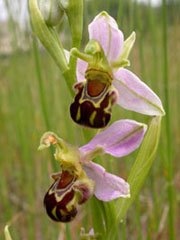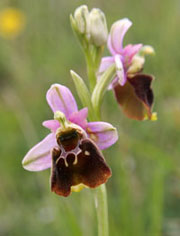Bee orchids and insect mimicry (video)
You need Adobe Flash Player, or an HTML5 enabled web browser, and JavaScript enabled to watch this video.
Visit the Adobe website to download the latest Adobe Flash Player
Join Museum botanist Fred Rumsey on the North Downs in Kent, UK, as he visits some very distinctive wildflowers. Bee orchids and other members of the group Ophrys have evolved an intriguing way of ensuring they are pollinated, by luring insects to try to copulate with them. Find out more in the video above.

The furry lip of the bee orchid, Ophrys apifera, mimics a bee
Insect mimicry
Bee orchids (Ophrys apifera) are easily identifiable by their eye-catching flowers, which are present during June and July. The attractive flowers mimic an insect feeding on a flower – with a furry lip that looks like the body of a bee, 2 sepals (the outermost parts of a flower) that look like antennae and another 3 outer sepals that resemble large pink petals.
As a result of this deception and an attractive scent, male bees try to mate with the lip of the flower (known as pseudocopulation). This mimicry has been favoured by natural selection because the bees unwittingly bring about pollination of the orchids by transferring pollen to the female parts of the next flower they visit.
Bee orchids don’t depend on bees to reproduce, however, and in Britain they are generally self-pollinated. But the closely related fly orchid (Ophrys insectifera), early spider orchid (Ophrys sphegodes) and late spider orchid (Ophrys fuciflora) are reliant on their insect pollinators and also lure them with fake signals.
Looking for bee orchids in the UK
Of all the insect-mimicking orchids, you have the best chance of spotting a bee orchid. As the UK’s climate warms, this species is becoming more common and spreading northwards.
Bee orchids usually grow on dry, grassy slopes where the soil is chalky or sandy and there aren’t many nutrients. They are also likely to be found in urban areas, particularly on roadsides and old industrial sites.

The late spider orchid, Ophrys fuciflora, is very rare in the UK, growing at fewer than 10 sites.
Fly and spider orchids much rarer
The other Ophrys species are rare or declining in the UK, so you are far less likely to see them.
Fly orchids were once widespread, growing at the edge of woodland and in clearings. But they have declined so rapidly and to such an extent that they are now listed as Vulnerable by the International Union for Conservation of Nature.
The rarest of the 4 British species is the late spider orchid. Very small populations are found at less than 10 sites in Kent. The early spider orchid is also rare, and largely restricted to the south coast of England. Both are protected by law under Schedule 8 of the Wildlife and Countryside Act (1981).
Unusual forms
The bee orchid is very variable in terms of colour, markings and flower shape. There is very little data on the distribution of these unusual forms (usually regarded as varieties) as they are under-recorded.
Photograph wild orchids
Help us find out if climate change is affecting the UK's wild orchids.
